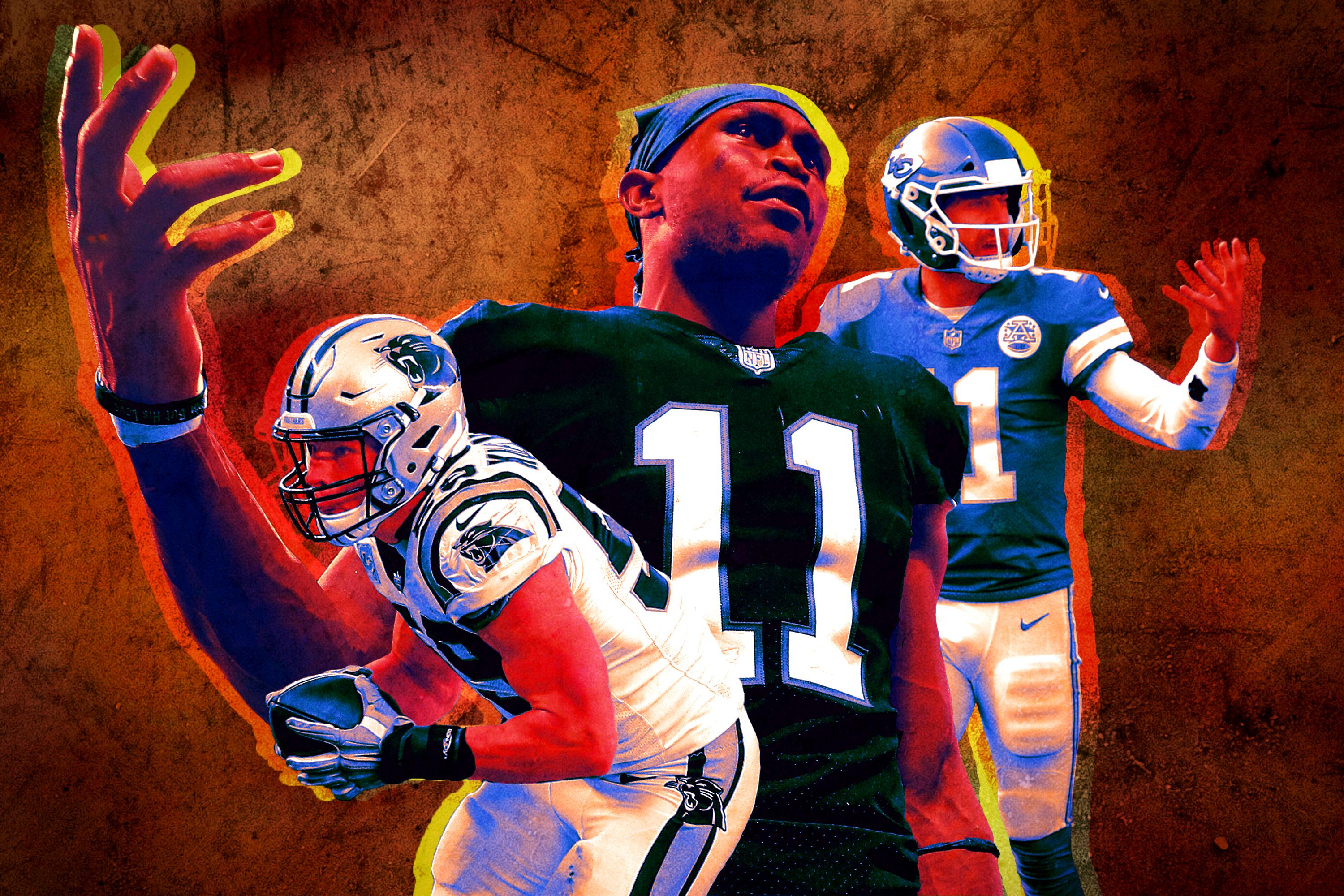
By Thanksgiving, most NFL teams — and most NFL seasons — are something close to fully formed. Late November is typically the right time to survey the landscape and determine who should be relevant come the playoffs. While the wild-card races in both conferences are messy, characterized by a massive middle class and a slew of complex tiebreaker scenarios, it should be possible to assess which squads could pose a real threat if they’re able to crack the postseason field.
I put together the Wild-Card Weekend Threat Index after Week 13 last fall in an attempt to sort through this cluster of would-be playoff teams and forecast how scary each would be if it made the postseason. Following a Week 12 this year that included notable results for virtually every possible wild-card participant, now feels like the right time to complete that exercise again in 2017.
Here’s a breakdown of the outlook for every realistic playoff contender that isn’t leading its division, divided up into tiers based on which teams could make a deep run in January and which seem more likely to fall flat.
Tier 1: Teams No One Wants to See in Round 1
Teams: Falcons, Chargers, Seahawks
It’s not hard to figure out what these three teams have in common. Each has a reliable quarterback, and that’s typically the no. 1 factor in evaluating any club’s postseason ceiling. Atlanta’s 34–20 win over the Buccaneers on Sunday was its third in a row, and more importantly, marked the third consecutive game in which the Falcons offense got rolling. Matt Ryan was excellent, completing 26 of 35 passes for 317 yards with a touchdown. Nearly two-thirds of that production came through connections to Julio Jones, who finished with a ridiculous 12 catches for 253 yards and two scores. Even if this team’s offense isn’t as potent as the one that went to last season’s Super Bowl, the amount of talent in that huddle makes Atlanta a daunting challenge for any potential playoff foe. This group has hit its stride after some early stumbles, and two factors should decide its postseason fate. Atlanta has a brutal schedule down the stretch — it hosts the Vikings next week, has two remaining matchups with the Saints, and plays the Panthers in its regular-season finale — yet it owns head-to-head wins over almost every other potential NFC wild-card representative (Seahawks, Lions, Cowboys). After a 4–4 start plagued by inconsistency, the Falcons’ playoff prospects and potential if they get there are suddenly looking up.
The same holds true for the Chargers, who looked dead in the water as recently as a few weeks ago. Sitting at 3–6 after a baffling overtime loss to the Jaguars, Los Angeles was being linked to draft conversations instead of playoff hypotheticals. On the heels of a resounding 28–6 Thanksgiving Day win over Dallas, though, Philip Rivers and Co. look like one of the scariest teams in football. That starts with the two pass rushers who define the L.A. defense. Any team that can generate consistent pressure has a puncher’s chance to make a run, and with Joey Bosa and Melvin Ingram terrorizing quarterbacks, the Chargers might boast the most talented tandem in the league. What makes this unit truly frightening is that the pieces around those two edge rushers have fallen into place. Cornerback Casey Hayward (who picked off his fourth pass of the season against the Cowboys) is playing like one of the best cover guys in the NFL, and the rest of the secondary has followed suit. Fifth-round 2017 pick Desmond King — who returned a Dak Prescott interception 90 yards for a score on Thursday — has proved to be one heck of a find, and veteran safeties Tre Boston and Jahleel Addae have settled into first-year coordinator Gus Bradley’s defense. Combine that with the offensive reemergence of Rivers (27-of-33 passing for 434 yards with three touchdowns in Dallas) and Keenan Allen (11 catches for 172 yards, his second straight game with double-digit receptions and at least 150 yards), and the Chargers become an unwelcome sight for any opposing team in Round 1. Now at 5–6, they’re only a game back of the Bills for the second wild-card spot and somehow also a game back of the Chiefs in the AFC West.
Unlike the Falcons and Chargers, the Seahawks are trending in the wrong direction. A 24–13 victory over the 49ers lifted Seattle to 7–4, but a rash of injuries means that the ferocious defense we’ve come to know now ceases to exist. With Richard Sherman and Kam Chancellor out for the remainder of the year, half of the Legion of Boom is on the shelf. Still, the personnel that remains healthy is full of Pro Bowl–caliber talent. Earl Thomas, Michael Bennett, and Bobby Wagner (who was brilliant again Sunday, notching an interception, two tackles for loss, and two quarterback hits) present a trio that most teams would gladly take, even if this shorthanded unit is a far cry from the ones that led the NFL in points allowed for four straight years.
Why, then, does Seattle deserve mention in this tier alongside two of the league’s hottest teams? Part of the rationale has to do with the remaining defensive players, but most of it is about Russell Wilson. The Seahawks offense has been unwatchable in stretches this fall, and against a shoddy 49ers defense it managed only 90 rushing yards on 30 carries. But Wilson’s potential for a monster day is always there. Count out the Wilson–Pete Carroll pairing at your own risk.
Tier 2: The NFC’s Potential Headaches
Teams: Panthers, Cowboys, Packers
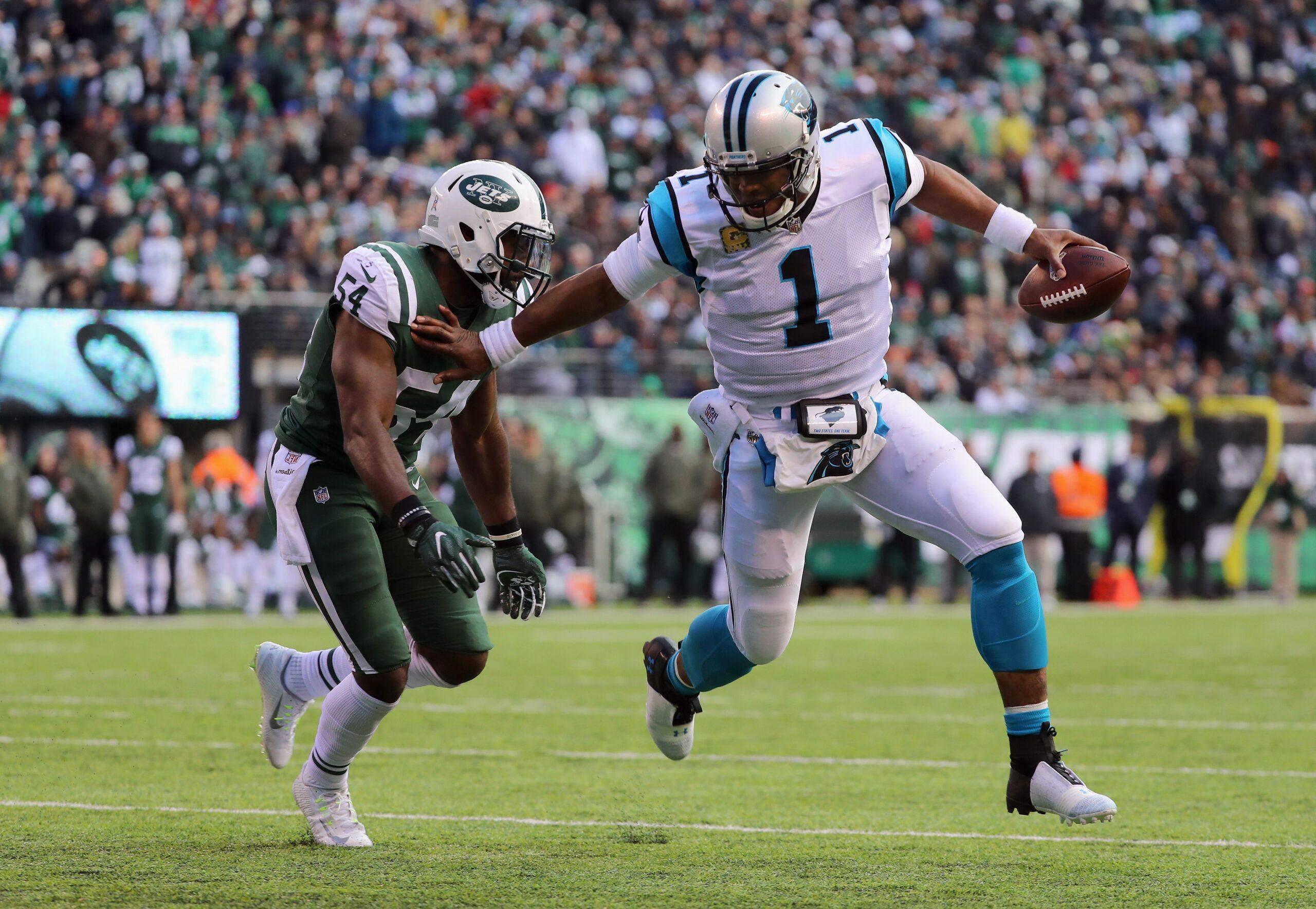
Carolina and Dallas are in drastically different positions, but at full strength both could be absolute pains for opponents to deal with in the postseason. A 35–27 win over the Jets on Sunday brings the Panthers to 8–3, pulling them even with the Saints in the NFC South. (New Orleans holds the tiebreaker based on its head-to-head victory in Week 3.) Even if they don’t win their division, though, the Panthers have a stranglehold on the wild-card race. And their defense should make them a tough out in January.
While Carolina allowed Jermaine Kearse and Robby Anderson to rack up 251 combined receiving yards Sunday, this unit been effective in nearly every game that it’s played in 2017. It ranked sixth in Football Outsiders’ defensive DVOA entering Week 12 and can wreak havoc when both Luke Kuechly and Kawann Short are healthy. The Panthers offense is prone to fits of inefficiency, as Cam Newton went 11-of-28 passing for 168 yards against the Jets, and Jonathan Stewart finished with 15 carries for 26 yards. Yet that group has flashed the occasional big-play potential, and it needs to do only so much when guys like Kuechly are doing things like this.
The Cowboys’ outlook isn’t so rosy. Dallas dropped its third straight game in blowout fashion against the Chargers, knocking its record to 5–6 and putting it in position to watch from the couch come wild-card weekend. But this squad warrants mention based on what we’ve seen it accomplish when all of its key pieces are available. If the Cowboys do manage to climb back into the playoff picture, they’ll have Ezekiel Elliott in the fold, and the best version of this team makes for a terrifying first-round draw.
The Packers have to be included in this tier as well, only because an unlikely late-season push would mean the all-but-certain return of Aaron Rodgers. Green Bay’s playoff hopes were probably dashed when Pittsburgh kicker Chris Boswell hit a 53-yard field goal to seal a 31–28 Steelers victory Sunday night, and the Packers have looked lost since Rodgers went down with a broken collarbone in Week 6. If they do miraculously sneak into the postseason, though, Rodgers is worth losing sleep over.
Tier 3: The Best Squad Lacking a Reliable QB
Team: Jaguars
Jacksonville boasts what might be the league’s best defense, led by a fearsome pass rush and the cornerback duo of Jalen Ramsey and A.J. Bouye. This group leads the league in sacks (41), turnovers (25), and points per game allowed (15.3), and it scored a touchdown on Calais Campbell’s 10-yard fumble recovery in Sunday’s 27–24 loss to the Cardinals.
The problem is that right now the defense feels as likely to put up points as the offense is. And the reason that the Jaguars dropped Sunday’s game to Arizona is the same one that could limit them in the playoffs: Their quarterback is Blake Bortles. He went just 19-of-33 passing for 160 yards in Arizona, and threw a backbreaking interception to Tyrann Mathieu that sunk the Jags’ comeback hopes and gave Tennessee the edge in the AFC South. If Jacksonville’s ground game stalls like it did Sunday (Leonard Fournette had only 25 yards on 12 carries), this offense has major problems. That undeniably limits its upside in the playoffs.
Tier 4: Teams Just Feisty Enough to Pull One Upset
Teams: Lions, Ravens, Bills
It wouldn’t be shocking to see any of these teams put up a fight if they crack the postseason field. The Ravens defense presents problems for just about every offense in the league, as it’s loaded with talent at every level and came into Week 12 ranked first in defensive DVOA. Baltimore’s issue is that it needs games to turn into ugly, low-scoring affairs to have any real chance to succeed. Joe Flacco is having a miserable year, and a slew of offensive line injuries have kept Baltimore from establishing a dependable presence on the ground. On one side of the ball, the Ravens are formidable; on the other, their lack of firepower severely limits their prospects.
Detroit doesn’t have one defined weakness like the Ravens do, but it also doesn’t have any easily identifiable strength. The Lions have made huge defensive strides since last season, yet they still rank only among the middle of the pack by most measures. And their offense has been held back by its nonexistent running game. Despite that, Matthew Stafford has access to enough weapons through the air to give Detroit a shot against anyone on the right day. The pair of sideline catches made by Kenny Golladay and Marvin Jones Jr. in the Lions’ 30–23 loss to Minnesota on Thanksgiving provided a glimpse into what could propel Detroit to a Round 1 surprise if it makes a surge over the next couple of weeks.
And one week removed from the Nathan Peterman fiasco, the Bills looked like an NFL team again in their 16–10 win over the Chiefs. Both the Ravens and Lions are more imposing threats at this point, but Buffalo’s backfield pairing of Tyrod Taylor and LeSean McCoy has shown that it can conjure offense out of nowhere. The Bills aren’t as frightening as they were early in the 2017 campaign, yet they’re still clearly more dangerous than the teams at the bottom of the wild-card race.
Tier 5: The Gamblers’ Delights
Teams: Raiders, Bengals, Redskins
It would seem like memories of last season would lift the Raiders out of this tier, but unlike the cases with the Cowboys and Packers, a more complete version of Oakland isn’t looming on the horizon. This is who the 2017 Raiders are: They have a solid but unspectacular offense, and it isn’t nearly enough to make up for their putrid defense. Oakland surrendered only two touchdowns in a 21–14 win over the Broncos on Sunday, but that’s not especially impressive given that it came against Paxton Lynch and Trevor Siemian. Even if this team gets hot and slides into the postseason, the league’s worst defense is going to hold it back.
Cincinnati and Washington don’t lack balance. They just don’t bring much to the table, either. The Bengals hung 30 points on the Browns this week thanks mostly to a strong day on the ground, but their offense has struggled for most of the fall. One above-average outing against a winless Cleveland team doesn’t change that. For Washington, the defense has crashed back to earth following a strong start, and injuries have ravaged the offense. This group gave New Orleans a scare before collapsing last week, but just about every other potential NFC wild-card team represents a bigger threat.
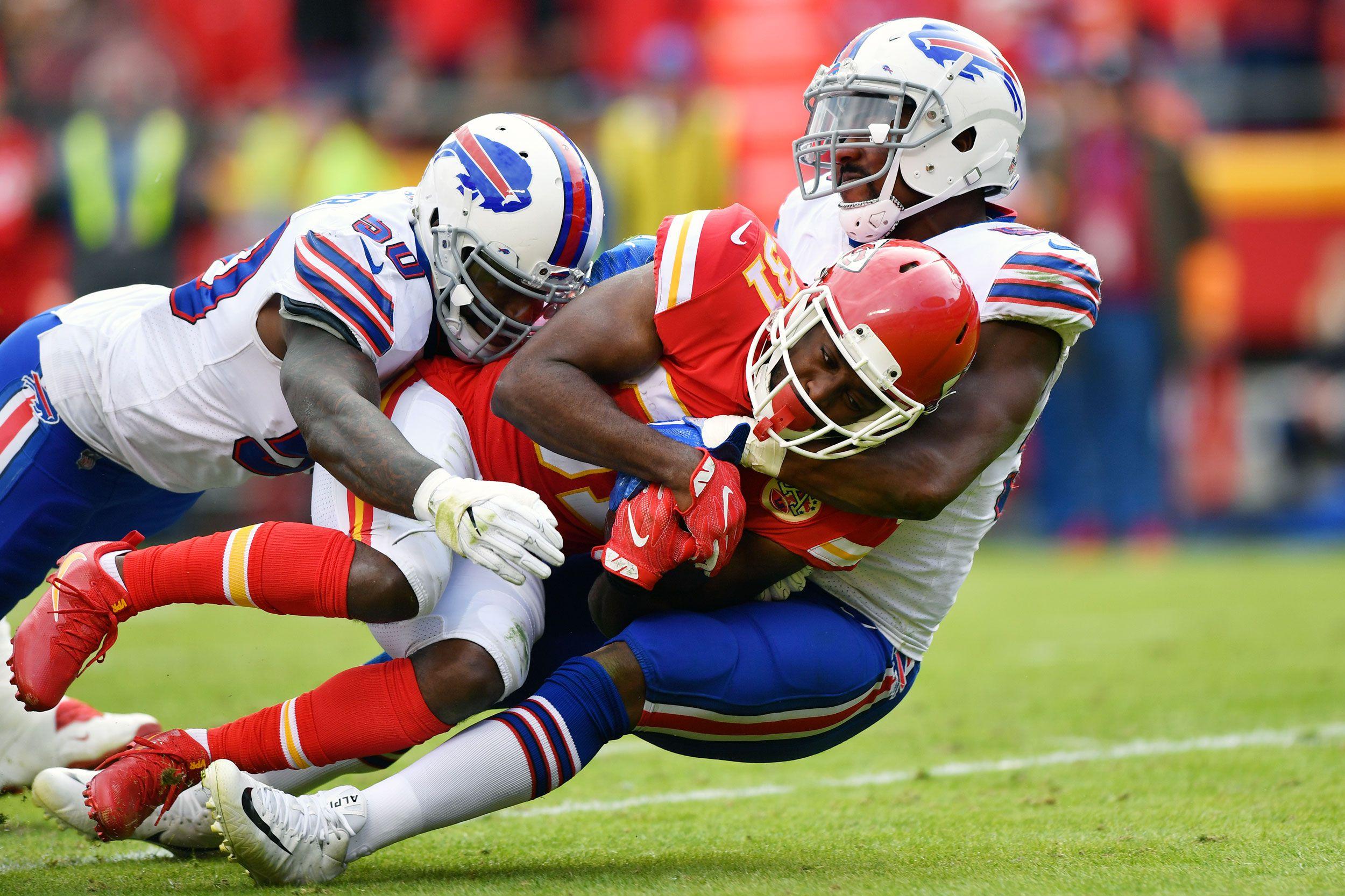
The Starting 11
A look at 11 big story lines, key developments, and interesting tidbits from this week in the NFL.
1. After Sunday’s loss to Buffalo, the Chiefs’ high-flying offense feels like a distant memory. Kansas City put up 10 points or fewer for the second straight game in Week 12. It took Alex Smith 36 pass attempts to reach 199 yards, and the Chiefs were limited to a single deep completion on the day. After looking like the most dangerous unit in football throughout a dazzling 5–0 start to the season, this offense has reverted into the type of group that held back the team in years past. The murmurs about replacing Smith with 2017 first-round draft pick Patrick Mahomes II under center will undoubtedly grow louder in the coming days, even if Kansas City sits atop the AFC West and the word is that the rookie simply isn’t ready. Smith will almost certainly finish the season as the Chiefs’ starting quarterback.
And while Smith’s slide from MVP candidate to potential team weakness will receive most of the national attention, it’s worth pointing out that the collapse of Kansas City’s running game has played a significant role in this mess. After rushing for at least 100 yards in four of his first five games, Kareem Hunt has cracked the 80-yard mark just one time since. He had just 17 yards on 11 carries against the Bills as the interior of the Chiefs offensive line struggled. At this point, Kansas City’s offense feels like a baseball pitcher with a wonky delivery working through a lineup for the second time. The novelty of this group has worn off; what’s left is the same uninspiring product that the Chiefs have rolled out in recent years.
2. When Julio Jones plays like he did Sunday, the Falcons get frightening in a hurry. Jones was spectacular against the Bucs, and his 253-yard outing was a reminder that the receiver is capable of taking over a game at any time. The version of Jones that lit up Tampa Bay showcased all that no. 11 has to offer: He made plays down the field (including on a wide receiver pass from Mohamed Sanu), reeled in contested grabs along the sideline, and ran plenty of crossing routes that allowed him to do work after the catch. The Bucs had absolutely no answer.
Atlanta’s offense was dominant in 2016 in part because it didn’t have to rely on Jones to register double-digit catch totals as it marched up and down the field. Come playoff time, though, the Falcons looked to Jones every time that they needed a huge play. Matt Ryan’s improved play over the second half of this season has been a big reason the Falcons are well positioned to nab the NFC’s second wild-card spot. Still, Jones remains the key to unlocking this team’s full offensive potential.
3. The Patriots’ stable of skill-position players is a nightmare for opposing defenses. New England benefits from having a 40-year-old quarterbacking robot who’s playing some of the best football of his career, but this team has the league’s best offense for reasons that go beyond Tom Brady. Even with Julian Edelman out with an injury, Brady has the most talented supporting cast that he’s had in some time. Rob Gronkowski — who had five catches for 82 yards with two touchdowns in a 35–17 win over the Dolphins — remains a hellish matchup near the goal line and is on pace to finish with more than 1,100 receiving yards. Brandin Cooks — who caught an intermediate throw and scampered for a 37-yard gain Sunday, and who averages 17 yards per reception — is good for at least one huge play per game. And this team has an embarrassment of riches in the backfield.
Rex Burkhead wasn’t even the most celebrated offseason addition among New England running backs, but the former Bengals playmaker has given the Pats another versatile option. He scored a second-quarter touchdown against Miami by motioning into the left slot, toasting linebacker Chase Allen with an outside move, and corralling a Brady pass that was right on the money. Dion Lewis finished with 112 yards on just 15 carries, upping his per-carry average on the season to 5.1. Burkhead, Lewis, and Mike Gillislee could all be the most potent backfield threats on many teams; on this depth chart, they occasionally become afterthoughts.
4. Lost in the fervor of Wentzmania, Zach Ertz has emerged as a star for the Eagles. The 27-year-old tight end carved up the Bears for 103 yards on 10 catches in Sunday’s 31–3 rout. It marked Ertz’s best game of the year, but it was hardly an outlier. Among tight ends with at least 50 targets this fall, only Gronk and Travis Kelce are averaging more yards per route run than Ertz (2.01, according to Pro Football Focus). That’s the type of company Ertz deserves to be mentioned among at this point. The 6-foot-5 249-pounder is a mismatch in man coverage, is excellent at finding voids in zone coverage, and has been devastating in the red zone, where he’s hauled in 10 of his 13 targets with seven touchdowns. Ertz is Carson Wentz’s best passing option, and his rise has come in step with his quarterback’s.
5. Seahawks linebacker Bobby Wagner added to his sparkling season with a terrific performance against the Niners. Considering that the guy has been voted first-team All-Pro twice (2014 and 2016), it’d take a special campaign for Wagner to have a career season. But that’s exactly what he’s putting together in 2017. Wagner has been ridiculous in nearly every facet of the game, and his interception in Week 12 involved him straight-up stealing the ball from receiver Trent Taylor over the middle.
Wagner has been fantastic in coverage for the Seahawks defense, no matter what he’s been asked to do. He’s tied for the best run-stop percentage among all inside linebackers, according to Pro Football Focus, and this year he’s brought more value than ever as a pass rusher. Despite playing only 35 snaps as a pass rusher coming into Sunday’s game, Wagner had two sacks and 11 total pressures, making him one of the most efficient blitzers in the NFL. Factoring in that kind of pass-rush ability with everything else he does is almost unfair. The number of tasks that Wagner performs — and performs well — makes him a candidate for Defensive Player of the Year.
6. The Titans pulled out another ugly win, but Marcus Mariota’s showing against the Colts continued a disheartening season for the Tennessee passing game. By throwing two more interceptions in Indianapolis, Mariota now has 12 on the year after tossing nine all of last season. One of those two picks was the result of a receiver falling down, but the other was a misplaced throw that the third-year passer simply doesn’t make when he’s at his best. Turnovers have crushed the Titans all year, as they came into Sunday ranked 26th in turnovers per drive.
The amount of talent in the Tennessee offense is always going to produce some intriguing flashes, as proved by rookie receiver Corey Davis making an excellent catch Sunday and Mariota delivering a 37-yard dime to Delanie Walker. But this group’s inconsistency is maddening, and it hasn’t shown signs of figuring things out.
7. The Rams offense has been a topic of fascination all season, but coordinator Wade Phillips’s defense is the group that makes this team a real threat in the NFC playoffs. Save for a few big plays by Alvin Kamara (who we’ll get to in a minute), the Rams held New Orleans’s ground game in check throughout Sunday’s 26–20 win. Outside of Kamara’s 74-yard first-quarter touchdown, Saints backs averaged just 2.9 yards per carry on their 15 other runs, and Mark Ingram finished with only 31 yards on 11 attempts. The pass rush proved effective, too: One play after Aaron Donald sacked Drew Brees in the first quarter, Robert Quinn jumped in a time machine and beat Terron Armstead to notch a drive-ending strip-sack.
This could have been an even bigger win for L.A. had it been able to haul in a few Brees passes that should have been interceptions. Brees turning in a subpar game like he did in Week 12—22-of-32 passing for 246 yards — is rare, but the Rams have the kind of group that can make it happen.
8. Alvin Kamara was at his very best in the Saints’ loss. The rookie needed only 11 touches to pile up 188 total yards against the Rams, and those numbers don’t do justice to how great Kamara was in this game. His 74-yard touchdown scamper was a product of vision and burst, but the rest of his dominance came via extraordinary work in the open field. Kamara seemed to leave a trail of Rams flailing in his wake every time he touched the ball. New Orleans is content to toss swing passes to Kamara near the line of scrimmage and let him do the rest. It usually works.
The olé that Kamara pulled on Trumaine Johnson along the right sideline in the second quarter was positively filthy. In the fourth quarter, he caught a pass in the left flat, spun away from Mark Barron, and then proceeded to leap over Kayvon Webster. Kamara’s ability to stop and get back up to full speed in the blink of an eye is special.
9. This week’s line-play moment that made me hit rewind: Brandon Graham’s third-quarter strip-sack.
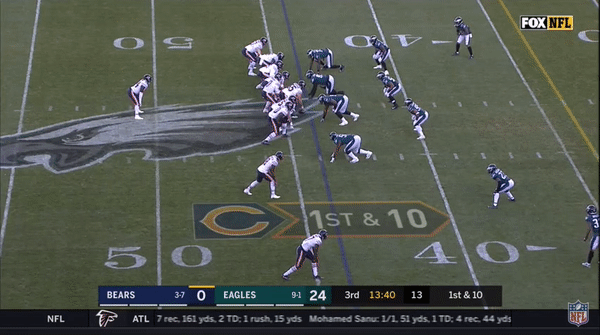
It feels like a different member of the Eagles’ front four makes a devastating play every week. Sunday, it was Graham’s turn. He beat Bears right tackle Bobby Massie around the left side on this first-and-10 play early in the third quarter, knocking the ball out of Mitchell Trubisky’s hands just before he could unload a throw. Graham’s move didn’t look like much, but it had a massive impact. By delivering a quick punch to Massie just as the tackle was about to deliver his own, Graham created enough separation to work his way around the edge. This is the norm for Philly’s defense.
10. This week in tales of the tape: The Chargers use alignment to dial up a big play in the passing game.
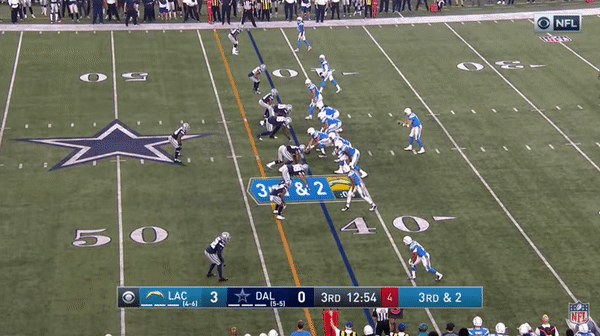
Undrafted free agent Austin Ekeler has been one hell of a find for the Chargers offense, and offensive coordinator Ken Whisenhunt got creative with his pass-catching back against Dallas. On this third-and-2 early in the third quarter, L.A. came out in an empty formation with Ekeler lined up wide to the left. Linebacker Justin Durant followed Ekeler, tipping off that the Cowboys were in man coverage. The Chargers had the perfect play to exploit it. Ekeler ran a simple stop-and-go double move that left Durant in the dust; Rivers tossed an on-target throw, and the Chargers had a 38-yard gain up the sideline. Using a running back as an outside receiver is a great way for an offense to diagnose a defense and create a coverage mismatch. Both of those happened here.
11. This week in NFL players, they’re absolutely nothing like us:
Antonio Brown, we are not worthy.